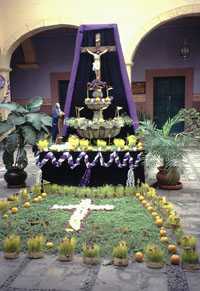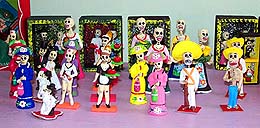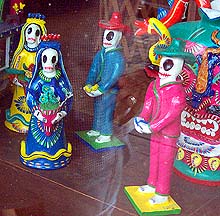PREPARING THE ALTAR
 Even
families with very limited budgets spare no expense when preparing the
altar to honor their family. They want their spirits to enjoy the
offerings and to return each year to continue this special spiritual
companionship. Even
families with very limited budgets spare no expense when preparing the
altar to honor their family. They want their spirits to enjoy the
offerings and to return each year to continue this special spiritual
companionship.
The altar is prepared in a place of honor in the home, using empty
boxes on a table to form a pyramid of three or more levels, then a white
tablecloth covers it all.
Four candles are placed on the top level to represent the cardinal
directions. A candle is lit for each dead family member, and one extra
so that no one is left out. The candles, which represent hope and faith,
burn during the night, so that there is no darkness.
Copal is the resinous sap of a Mexican tree, burned as incense since
the time of the Aztecs as an offering to the gods. On the Day of the
Dead altar, the scent attracts spirits, drawing them home. It is also
used to cleanse the area, and to ward off evil.
While most altars are laden with the favorite foods, sweets, drinks, and
harvest fruits of each family spirit, even the most basic altar includes
these basic needs:
- WATER to quench the thirst and for
purification
- SALT to season the food and for
purification
- BREAD to represent the food needed for
survival
A washbasin, soap, towel, mirror and comb are placed nearby so the
spirits can clean up when they return.
The hand crafted skeletons, Calaveras are funny and friendly
rather than frightening or spooky. They represent the beloved dead ones,
their occupations and hobbies. As they are placed on the altar, the
delightful skeleton figures bring back fond memories and cause the
grieving ones to smile. The figures with the smells of favorite foods,
help the spirits find the right house.
Three calaveras, which represent the trinity, are placed on
the second level.
Colorful tissue paper, papel picado, is cut into intricate
designs and strung to flutter over around the altar. This custom comes
from the Aztecs who used paper banners in rituals. The colors used
represent:

- Black for the Prehispanic religions and land of the dead
- Purple from the Catholic calendar to signify pain, suffering,
grief, mourning
- Pink for celebration
- White for purity and hope
- Yellow and Orange for the marigold, the sun, light
- Red representing for Christians, the blood of Jesus; and for the
indigenous, the life blood of humans and animals
Flowers, symbolizing the brevity of life, are massed and fashioned
into garlands, wreaths and crosses to decorate the altar and the grave.
The marigold is the most traditional flower of the season. In Aztec
times it was called the cempasuchil, the flower of 400 lives.
The fragrance of the cempasuchil leads the spirits home.
Sometimes paths of the petals lead out of the cemetery and to the house
to guide the spirits. A cross of marigold petals is formed on the floor
so that as the spirit approaches the alter, he will step on the cross
and expel his guilt.
Personal items of the spirits remembered, the child's toys, household
saints, photos of those honored are added to the altar, along with the
tools and utinsels used each day, serapes, guitars or drums, gourds for
carrying water and cigars or cigarettes.
 The
Mexican flatters and woos death, he sings to her, dances with her, lifts
his glass to her, he laughs at her. Finally, he challenges her, and in
the challenging, death loses her power to intimidate him Once he knows
death intimately, death is no longer wrapped in a cloak of mystery or
causes him to fear the darkness. The
Mexican flatters and woos death, he sings to her, dances with her, lifts
his glass to her, he laughs at her. Finally, he challenges her, and in
the challenging, death loses her power to intimidate him Once he knows
death intimately, death is no longer wrapped in a cloak of mystery or
causes him to fear the darkness.
Once the fear of death has been defeated, the clutch she has on the
hearts and minds of the living is lessened once and for all. Death's
morbid side is buried under music and remembrances, while skeletons
laugh and dance and sing as Mexico celebrates life in its embrace of
death.
This information comes from:
http://www.mexconnect.com/mex_/travel/jking/jkdayofthedead.html#altar |
 ¡En español!
¡En español!
 ¡En español!
¡En español!